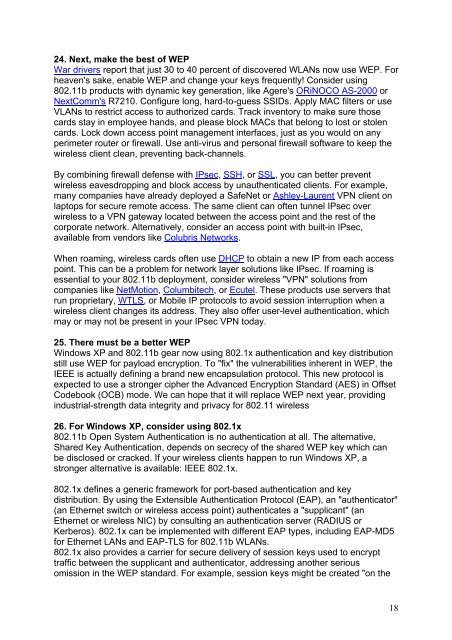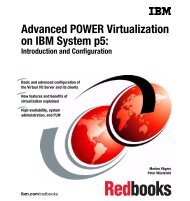Wireless LAN
Wireless LAN
Wireless LAN
Create successful ePaper yourself
Turn your PDF publications into a flip-book with our unique Google optimized e-Paper software.
24. Next, make the best of WEP<br />
War drivers report that just 30 to 40 percent of discovered W<strong>LAN</strong>s now use WEP. For<br />
heaven's sake, enable WEP and change your keys frequently! Consider using<br />
802.11b products with dynamic key generation, like Agere's ORiNOCO AS-2000 or<br />
NextComm's R7210. Configure long, hard-to-guess SSIDs. Apply MAC filters or use<br />
V<strong>LAN</strong>s to restrict access to authorized cards. Track inventory to make sure those<br />
cards stay in employee hands, and please block MACs that belong to lost or stolen<br />
cards. Lock down access point management interfaces, just as you would on any<br />
perimeter router or firewall. Use anti-virus and personal firewall software to keep the<br />
wireless client clean, preventing back-channels.<br />
By combining firewall defense with IPsec, SSH, or SSL, you can better prevent<br />
wireless eavesdropping and block access by unauthenticated clients. For example,<br />
many companies have already deployed a SafeNet or Ashley-Laurent VPN client on<br />
laptops for secure remote access. The same client can often tunnel IPsec over<br />
wireless to a VPN gateway located between the access point and the rest of the<br />
corporate network. Alternatively, consider an access point with built-in IPsec,<br />
available from vendors like Colubris Networks.<br />
When roaming, wireless cards often use DHCP to obtain a new IP from each access<br />
point. This can be a problem for network layer solutions like IPsec. If roaming is<br />
essential to your 802.11b deployment, consider wireless "VPN" solutions from<br />
companies like NetMotion, Columbitech, or Ecutel. These products use servers that<br />
run proprietary, WTLS, or Mobile IP protocols to avoid session interruption when a<br />
wireless client changes its address. They also offer user-level authentication, which<br />
may or may not be present in your IPsec VPN today.<br />
25. There must be a better WEP<br />
Windows XP and 802.11b gear now using 802.1x authentication and key distribution<br />
still use WEP for payload encryption. To "fix" the vulnerabilities inherent in WEP, the<br />
IEEE is actually defining a brand new encapsulation protocol. This new protocol is<br />
expected to use a stronger cipher the Advanced Encryption Standard (AES) in Offset<br />
Codebook (OCB) mode. We can hope that it will replace WEP next year, providing<br />
industrial-strength data integrity and privacy for 802.11 wireless<br />
26. For Windows XP, consider using 802.1x<br />
802.11b Open System Authentication is no authentication at all. The alternative,<br />
Shared Key Authentication, depends on secrecy of the shared WEP key which can<br />
be disclosed or cracked. If your wireless clients happen to run Windows XP, a<br />
stronger alternative is available: IEEE 802.1x.<br />
802.1x defines a generic framework for port-based authentication and key<br />
distribution. By using the Extensible Authentication Protocol (EAP), an "authenticator"<br />
(an Ethernet switch or wireless access point) authenticates a "supplicant" (an<br />
Ethernet or wireless NIC) by consulting an authentication server (RADIUS or<br />
Kerberos). 802.1x can be implemented with different EAP types, including EAP-MD5<br />
for Ethernet <strong>LAN</strong>s and EAP-TLS for 802.11b W<strong>LAN</strong>s.<br />
802.1x also provides a carrier for secure delivery of session keys used to encrypt<br />
traffic between the supplicant and authenticator, addressing another serious<br />
omission in the WEP standard. For example, session keys might be created "on the<br />
18
















